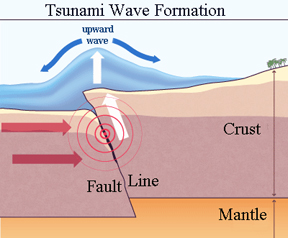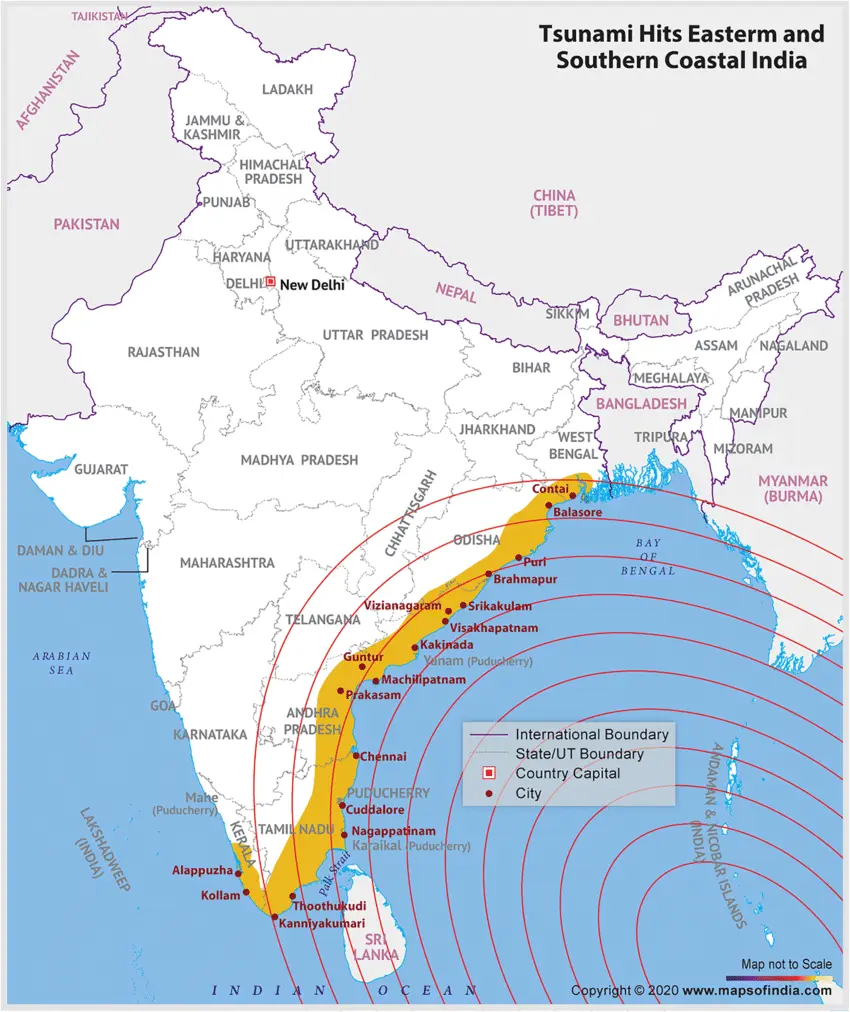Tsunami: Nature’s Powerful Force
Tsunamis are among the most destructive natural disasters on Earth. They are very long wavelengths of water caused by a large and sudden displacement of the ocean due to earthquakes, volcanic eruptions etc. They can create large scale damage to lives and infrastructure. In this article we will delve into the characteristics, its causes, formation and types.
Tsunami: A Brief Description
Originates from the Japanese term “wave harbour.”
- Nature: This consists of a succession of immensely large ocean waves.
- Cause: Tsunamis, as well as other natural disasters, result from abrupt and substantial disruptions in a body of water.
- Common Triggers: They are typically instigated by underwater earthquakes, volcanic eruptions, landslides, or meteorite impacts occurring within the ocean.
- Mechanism: These events displace a considerable amount of water, giving rise to the formation of an event.
Characteristics: Wavelengths, Speed, Energy, and Non-Periodic Nature
- Long Wavelengths: They can span hundreds of kilometres from one wave crest to another.
- As they approach shallow water near the coast, their height grows because of their long wavelengths.
- They cause more destruction near the coast
- Deceptive Speed: These move at very high speed in deep waters with height less than a metre. This makes them difficult to detect
- At 6000 m, it can travel at speeds about 850 km per hour.
- When an event hits shallow waters their speed falls.
- Energy Loss: This loses little energy as they propagate because the rate of energy loss of a wave is inversely related to its wavelength.
- Amplitude: In deep waters the amplitude is negligible as compared to wavelengths.
- Their amplitude increases when events approach shallow water, (conservation of energy).
- Non-Periodic Nature: These waves are not periodic unlike regular ocean waves.
- Series of Waves: They occurs in multiple waves with periods ranging from minutes to hours
- Generally, the subsequent waves are more dangerous than the first wave
Causes of Tsunamis: Earthquakes, Landslides, Volcanic Eruptions and Natural Disasters
The vertical movement of the seafloor generates Tsunami. Earthquakes are the main cause. However, there are other causes also including natural disasters:
- Earthquakes: The majority of tsunamis are caused by large, shallow earthquakes (magnitude larger than 7.0)
- When a significant seismic event occurs, the tectonic plates under the ocean slip, creating a classic wave.
- Water is forced several metres above the average sea level by the physical shifting of the plates.
- More than 80% of world’s occurrences happen in the Pacific along its Ring of Fire subduction zones
- Eg. Chile (1960), Indian Ocean Tsunami (2004)
-
Landslides : Events can occur when a landslide enters the ocean, bays, or lakes.
- A large mass of sand, mud and gravel may fall down the slope when an undersea landslide occurs.
- This will draw the water down and may cause an event.
- Eg. Puerto Rico (1918)
-
Volcanic Eruptions: Tsunamis generated by volcanoes, both above and below are less frequent. Volcanic activity responsible for generating Tsunamis –
-
Caldera Formations (volcanic collapse)
-
Pyroclastic flows
-
Lateral blasts
- Eg. Indonesia (1883), Kyushu Island, Japan (1792)
-
Meteorological Conditions : There is a potential that meteorological conditions can lead to an event.
-
Anthropogenic Factors: Underwater nuclear explosions can generate tsunamis.
- Eg. Nuclear Testing by the US generated Tsunami in 1940 and 1950s in Marshall Island.

Normal waves vs Tsunami waves
- Normal waves are caused by transfer of wind over the water but Tsunamis are generated by sudden displacement of the ocean, often resulting from natural disasters such as earthquakes below or near the ocean floor.
- Tsunamis have very long wavelengths so the volume of water they carry and the energy they transmit are dangerous.

Tsunami-Prone Regions: Hotspots of Earth’s Most Destructive Waves and Natural Disasters
These are certain areas in the world which are particularly prone to tsunamis and the devastation they can bring.
- 78% Pacific Ocean (around the geologically active “Ring of Fire”)
- 9% Atlantic Ocean and Caribbean Sea
- 6% Mediterranean Sea
- 5% Indian Ocean
- 1% Other Seas
- This is a map showing Tsunami prone areas in India

Tsunami Early Warning Systems: Global and Regional Protectors against Natural Disasters
Early Warning Systems consists of two primary elements:
- A sensor network that monitors seismic alerts in order to foretell the arrival of a tsunami wave
- A means of communication for informing the public and authorities
- Two types of Early Warning Systems:
- International:
-
- Pacific Warning Centre covers the Pacific ocean and provides warnings for a range of natural disasters.
- National Warning Centre covers North America and Gulf of Mexico
- Early Warning and Mitigation System in the North-Eastern Atlantic, the Mediterranean, and Connected Seas is a joint warning system established with the help of UNESCO.
Regional:
|
The Devastating Impact of Tsunamis and Other Natural Disasters: Losses and Consequences
- Coastal Devastation:
- Example: The 2004 Indian Ocean event caused widespread destruction along the coasts of Indonesia, Thailand, Sri Lanka, and India, resulting in the loss of human lives and damage to infrastructure.
- Flooding Inland:
- Example: The 2011 Tōhoku event in Japan inundated farmlands and urban areas, causing extensive damage and triggering the Fukushima Daiichi nuclear disaster.
- Economic Loss:
- Example: The 2011 Tōhoku event resulted in billions of dollars in economic losses, including damage to industries, ports, and transportation networks.
- Loss of Life:
- Example: The 2004 Indian Ocean event led to the tragic loss of over 230,000 lives across multiple countries.
- Environmental Impact:
- Example: The 2011 Tōhoku event in Japan damaged ecosystems and led to the release of pollutants, affecting marine life and coastal environments.
- Secondary Effects:
-
- Tsunamis, as well as other secondary effects of natural disasters, can lead to subsequent disasters, such as fires, landslides, and health crises, compounding the overall impact.































